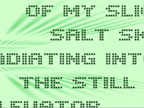September 25, 2006
Aya Natalia Karpinska

nobody knows but you + interview
nobody knows but you was written for Double-Cute Battle Mode, an application prototype for a VJ (video jockey) remix battle. DCBM allows two players to combine visuals and special effects in a playful competition for screen space. Using joysticks, players plug their imagination into their computer and share a creative space in an intuitive video-game style interaction. The piece was conceived as a way to ease text back into an image-dominated culture by treating it simultaneously as a visual special effect and as a poem.
The twenty-three verses appear on a plane in three-dimensional space. A cube shape displays additional visuals. Both the cube and the plane may be scaled and rotated, and the reader has control over which verse or image is displayed.
You may notice in the image at top left, or while watching the documentation video, a twelve-year-old girl plopped down in front of the installation. She played with the piece on and off for three hours. She began singing the words, making up melodies and turning certain verses into refrains. There is a clear lack of literature that responds to the intellectual and creative needs of young people today. I hope that interactive writing can help to fill that gap.
The original DCBM program was created with Carlos J. Gómez de Llarena.
- Aya Natalia Karpinska, Fall 2005
An Interview with Aya Karpinska on “mar puro” by Rita Raley, Iowa Review, v8 n3 September 2006
RR: How would you characterize your current work in three dimensional text and/or spatial poetry?
AK: This interview comes at an interesting time, when I am having serious doubts about pursuing spatial poetry, at least in the way I have approached it in the past. For one thing, a screen is a screen. It’s not space. The computer screen is a powerful interface, but I believe we are conforming to its demands as users, and not the other way around. I’m looking forward to exploring technology in physical spaces, where people are out and about living their lives. One technology that comes to mind is the mobile phone, which has already surpassed the computer as the digital device of choice for much of the world. Our spatial knowledge comes, of course, from physical space. Now we are out in space with a mini-computer in our pockets. But back to your questions…
RR: This is a general question, but would you be willing to speculate about the significance of the word or letter’s becoming three-dimensional? About what difference it might make for poetry, current paradigms of reading, our understanding of text? What do you find yourself able to achieve that was not possible with previous reading and writing technologies?
AK: With digital screen-based text, one thing that still intrigues me is overlapping. With mar puro and most of my other 3D poems, motion and interaction combine different parts of the text. You can create spontaneous relationships among the words, both as the author and as the reader. I could perhaps achieve a similar effect by printing on transparent sheets and instructing readers on how to move the sheets around, but that is cumbersome. The experience of the digital version is smoother.
As for an effect on current paradigms of reading… this is an important question. How are we going to engage younger audiences that grew up with video games and texting and surfing the Web? With a recent piece of mine, nobody knows but you, I wanted to answer that question by creating a space for readers to perform the text. I essentially placed text on the same level as image, and the reader can manipulate the size and position of each, like a VJ (video jockey). This is certainly not something I intend a reader to curl up with in bed – it’s designed for a club environment or similar social space. Mashing together multimedia and text can make the experience of reading more playful. In John R. Kelly’s concept of play, he emphasizes how we go about it, not just what we do. This is where interactivity comes in, the “how.”
Posted by jo at September 25, 2006 07:13 PM
